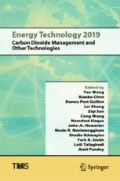Abstract
Heavy metals stay in the environment for large periods of time, which contribute to them being highly toxic and are associated to illness in human beings and biodiversity reduction. The present paper used Lactuca sativa L. and Lolium perenne to remove heavy metals from galvanoplastic waste polluted soil. Nickel, Cobalt, and Iron (adsorbents) from galvanoplastic waste were chosen as parameters in the biosorbents (roots, stem, and leaves). Particle size phytoextracted by L. sativa L. and L. perenne were analyzed using SEM (Scanning Electron Microscopy) and Atomic Absorption Spectroscopy (AA). It was determined that L. sativa L. has a greater absorption capacity, but a lower intrinsic velocity than L. perenne . The greatest survival time was presented by L. perenne .
Access this chapter
Tax calculation will be finalised at checkout
Purchases are for personal use only
References
Sarkar B (2002) Heavy metals in the environment. Marcel Dekker, Inc., United States of America
Kumar PBAN, Dushenkov V, Motto H, Raskin I (1995) Phytoextraction: the use of plants to remove heavy metals from soils. Environ Sci Technol
Ong ST, Yip SP, Keng PS, Lee SL, Hung YT (2012) Papaya (Carica papaya) seed as a low-cost sorbent for zinc removal. Afr J Agric Res
Thangavel P, Subhuram CV (2004) Phytoextraction—role of hyper accumulators in metal contaminated soils. In: Proceedings of the Indian national science academy
Ensley B (2000) Rational for use of phytoremediation In Raskin I, Ensley BD (eds)
Erdei L, Mezosi G, Mecs I, Vass I, Foglein F, Bulik L (2005) Phytoremediation as a program for decontamination of heavy-metal polluted environment. Acta Biol Szeged
Ndimele PE (2010) A review on the phytoremediation of petroleum hydrocarbon. Pak J Biol Sci
Delgadillo A, González C, Prieto F, Villagómez J, Acevedo O (2011) Fitorremediación: una alternativa para eliminar la contaminación. Tropical and Subtropical Agroecosystems
Author information
Authors and Affiliations
Corresponding author
Editor information
Editors and Affiliations
Rights and permissions
Copyright information
© 2019 The Minerals, Metals & Materials Society
About this paper
Cite this paper
Hernández, A., Loera, N., Contreras, M., Fischer, L., Sánchez, D. (2019). Comparison Between Lactuca sativa L. and Lolium perenne: Phytoextraction Capacity of Ni, Fe, and Co from Galvanoplastic Industry. In: Wang, T., et al. Energy Technology 2019. The Minerals, Metals & Materials Series. Springer, Cham. https://doi.org/10.1007/978-3-030-06209-5_14
Download citation
DOI: https://doi.org/10.1007/978-3-030-06209-5_14
Published:
Publisher Name: Springer, Cham
Print ISBN: 978-3-030-06208-8
Online ISBN: 978-3-030-06209-5
eBook Packages: Chemistry and Materials ScienceChemistry and Material Science (R0)

